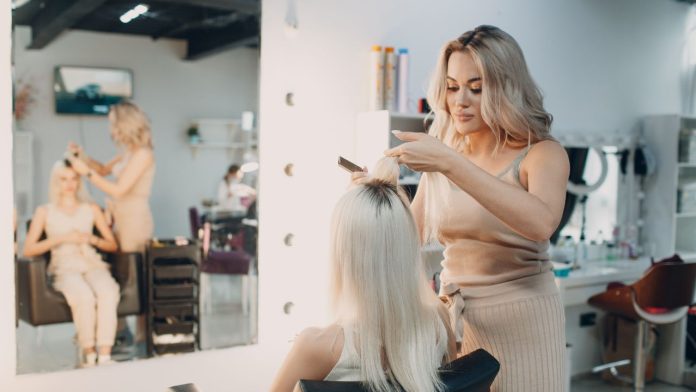Synthetic hair extensions have emerged in the market as an economical and fashionable way to elevate your looks. If you compare synthetic hair vs human hair, the former has certain limitations.
They cannot tolerate the same level of heat as human hair, which can limit styling options. The good news is that there are many other ways to achieve a great look with synthetic hair without using heat.
This blog post will shed light on the various heat-less styling techniques to enable people to obtain beautiful looks and keep synthetic fibers safe.
Why Should You Not Style Synthetic Hair With Heat?
Synthetic hair is made from artificial fibers and cannot withstand heat like natural hair subjected to styling. It is also advised not to expose the product to heat from styling tools, as it may damage the delicate synthetic fibers and result in frizzling or crimping of the fibers. Furthermore, the impact of sol is negative, given that by exposing this hair to heat, it becomes weak, and the texture changes, hence reducing its lifespan.
Heat-Free Styling Ideas for Synthetic Hair Extensions
While synthetic hair cannot be styled with heat, there are plenty of heat-free techniques to explore:
Steam or Warm Water Styling
Steam or warm water is an excellent alternative for shaping synthetic hair without using direct heat. By applying controlled steam or soaking the hair in warm (not boiling) water, the synthetic fibers can be molded into various styles.
For example, rolling the hair with curlers and then exposing it to steam allows the curls to set without damage. This method is gentle yet effective, providing long-lasting curls or waves. It’s crucial, however, to avoid excessive heat and always use this technique with care.
Cold Setting with Rollers
For those looking to achieve curls or waves without any heat, a cold setting with rollers is an ideal option. Simply dampen the synthetic hair lightly and wrap it around rollers, leaving it to set overnight.
In the morning, the hair will hold the curl or wave pattern without any risk of damage. This technique is particularly effective for synthetic hair, as it allows the fibers to adapt to the shape of the rollers while maintaining their structural integrity.
Embellishing with Beads and Rhinestones
There is another unique and non-heat styling method that can also be used on synthetic hair; this is the use of other ornaments including beads, rhinestones, among others When some of these additions are made on simple hairstyles such as braids, ponytail, twists, among others, they are likely to have a different appearance which is likely to suit a given individual.
Beads can be strung on single strands or twisters to add a cute and natural touch, or rhinestones can be affixed to the hair using a sticky solution to add glitz to the style.
Effective Styling Products
Using the right styling products is key to maintaining the look and health of synthetic hair extensions. Specialized detanglers, leave-in conditioners, and lightweight gels can help manage frizz and add definition to styles. Products specifically designed for synthetic hair ensure that the fibers stay smooth, shiny, and free of tangles.
These products also make it easier to create various styles without using heat, providing added hold and flexibility. Avoid heavy or oil-based products, as they can weigh down synthetic hair and cause it to look dull.
Creative Braiding, Twisting, and Buns
Braiding: Braids do not need heating tools and can be made by anyone with synthetic hair. Ranging from standard three-line braids to complex fish braids, there is something for everyone. Synthetic hair weave provides some texture that gives a longer-lasting style.
Twisting: Twists are another easy, heat-free option for synthetic hair. They create a sleek, polished appearance while minimizing stress on the hair. Twists can be left in for a casual look or pinned up for a more formal style.
Buns: Buns are a quick and stylish way to manage synthetic hair. Whether it’s a sleek, tight bun or a messy, voluminous one, buns keep synthetic hair in place while offering a chic, polished finish.
Can You Dye Synthetic Hair Extensions?
Synthetic hair extensions therefore should not be dyed as they cannot absorb color as natural hair does. It can be a challenge to use synthetic hair for hair dye since the traditional dyeing processes may adversely affect the hair or change its texture.
However, some specialized fabric dyes, designed for synthetic materials, can be used with caution. It’s important to follow all instructions carefully and test a small section before committing to a full-dye job. For those seeking color changes, buying pre-dyed synthetic extensions is often the best option.
Conclusion
Many people find that the lack of heat when styling synthetic hair can be quite confining, but it is not really the case, as there are so many opportunities to create any unique style. From curling with steam or cold rollers to adding accessories or trying out different hairstyles, such techniques are non-destructive and appropriate for synthetic hair.
Additionally, choosing the right styling products can enhance the overall look without causing damage. While synthetic hair has its limitations, understanding how to work within them allows for exciting and fashionable results without compromising quality.











